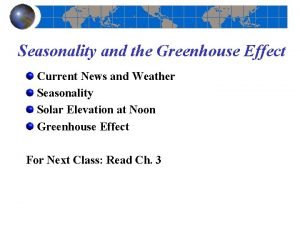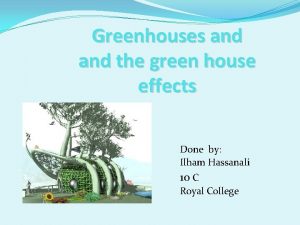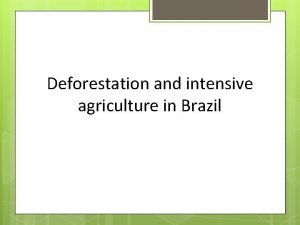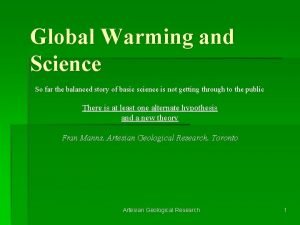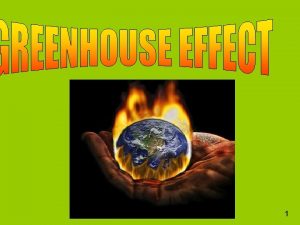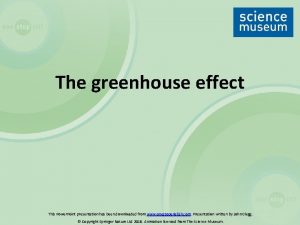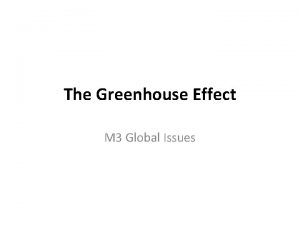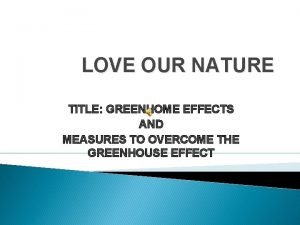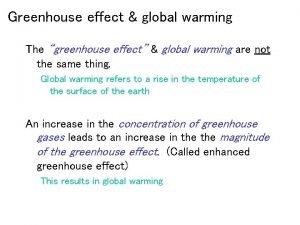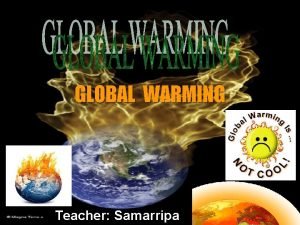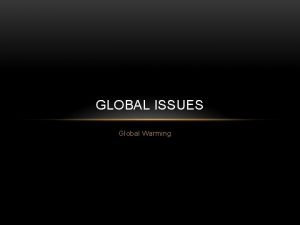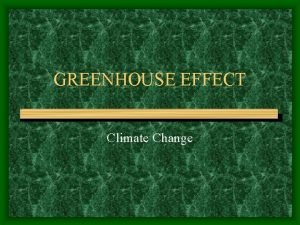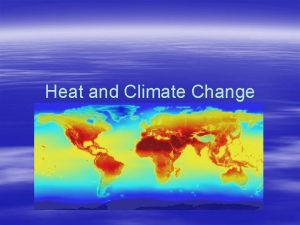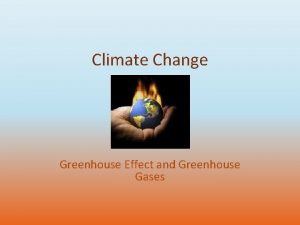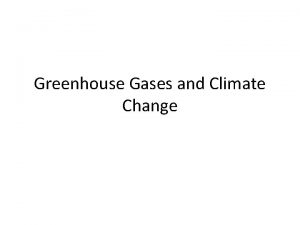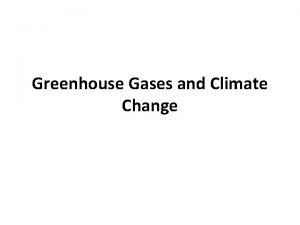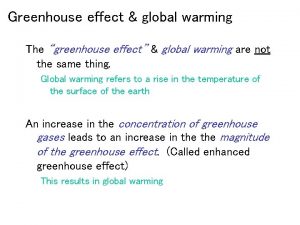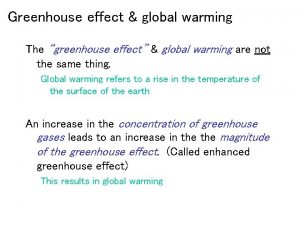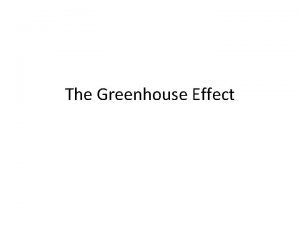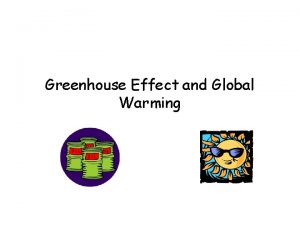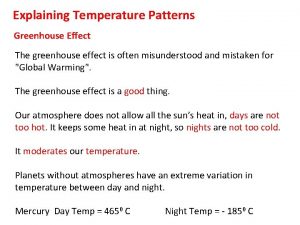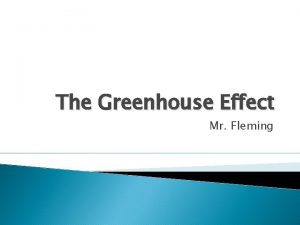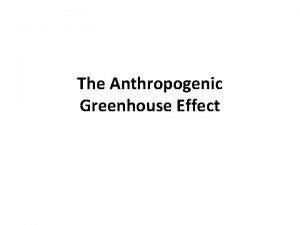The Greenhouse Effect Climate Change Weather vs Climate




















- Slides: 20

The Greenhouse Effect & Climate Change

Weather vs. Climate Weather: atmospheric conditions, including temperature, precipitation, wind, and humidity, in a particular location over a short period of time, such as a day or a week Climate: the average of the weather in a region over a long period of time

How does the Greenhouse Effect work?

1. High-energy radiation from the Sun enters the atmosphere.

2. It is converted to heat energy and emitted from the Earth’s surface.

3. Certain gases in the atmosphere trap some of the radiation from Earth’s surface and radiate it back, warming the atmosphere

What is a Greenhouse Gas? • Any gas in the atmosphere that absorbs and emits infrared radiation (thermal energy) from the Earth • Most of the air in the atmosphere is made of N 2 and O 2 which do not absorb radiation from the surface of the Earth

Infrared (long-wave) Radiation

Greenhouse Gases • Consist of less than 1% of the atmosphere • It is their concentration in the atmosphere which determines how much energy they can absorb

Greenhouse Gases • Greenhouses gases include: • H 2 O • CO 2 • CH 4 (methane) • N 2 O nitrous oxide • CFC’s • (and a few others) • Produced “naturally” AND by human activities

We need the Greenhouse Effect! • The heat from the natural greenhouse effect warms Earth’s atmosphere an average of 33°C • Eventually, this heat dissipates to outer space • If there were no greenhouse effect, Earth’s average temperature would be 19°C—Impossible for life as we know it!

Enhanced Greenhouse Effect (Human impact on the Greenhouse Effect) Humans are increasing the concentrations of greenhouse gases

Water Vapour (H 20) (95% of Earth’s greenhouse effect) • Part of the “natural” greenhouse effect - Human activities do not release significant amounts of water vapour into the atmosphere -remains on average for 9 days • Most abundant greenhouse gas • Sources: • Evaporation • Plant transpiration

Carbon Dioxide (CO 2) • Main Sources: • Burning fossil fuels- coal, oil and natural gas • Increases due to the removal and burning of forests

Nitrous oxide (N 20) • Main sources: • Burning of biomass • Burning of fossil fuels • Released by bacteria from soil fertilizers • Traps heat 296 times better than carbon dioxide

Methane (CH 4) • Main Sources: • Production, distribution, burning of fossil fuels • Livestock farming (animal waste) • Landfills & waste

The Important Greenhouse Gases (except water vapor) U. S. Department of Energy (all concentrations expressed in parts per billion) Carbon Dioxide (CO 2) Methane (CH 4) Nitrous Oxide (N 2 O) Misc. gases ( CFC's, etc. ) Total Pre. Total Natural Man-made Percent of industrial Concentration additions Total baseline (ppb) 288, 000 68, 520 11, 880 368, 400 99. 438% 848 577 320 1, 745 0. 471% 285 12 15 312 0. 084% 25 0 2 27 0. 007% 289, 158 69, 109 12, 217 370, 484 100. 00% Think about it: 1) What is the most abundant gas? 2) Which gas do you think will have had the largest % increase (total) post industrial revolution? 3) Which has had the largest % increase (total) post industrial revolution?

The Remaining 5% • Water vapor accounts for about 95% of Earth's greenhouse effect • The remaining 5% is shown below. These charts shows human influence on the remaining 5% of greenhouse gases

Anthropogenic (man-made) Contribution to the "Greenhouse Effect, " expressed as % of Total (water vapor INCLUDED) Based on concentrations (ppb) Water vapor Carbon Dioxide (CO 2) Methane (CH 4) Nitrous Oxide (N 2 O) Misc. gases ( CFC's, etc. ) Total % of Greenhouse Effect % Natural % Man-made 95. 000% 94. 999% 0. 001% 3. 618% 3. 502% 0. 117% 0. 360% 0. 294% 0. 066% 0. 950% 0. 903% 0. 047% 0. 072% 0. 025% 0. 047% 100. 00% 99. 72 0. 28%

In Summary • Water vapor which is responsible for 95% of Earth's greenhouse effect, is 99. 999% natural. Even if we wanted to we can do nothing to change this. • Anthropogenic (manmade) CO 2 contributions cause only about 0. 117% of Earth's greenhouse effect. • Adding up all anthropogenic greenhouse gas sources, the total human contribution to the greenhouse effect is around 0. 28%.
 Climate change 2014 mitigation of climate change
Climate change 2014 mitigation of climate change Thank you
Thank you Why is the greenhouse effect important
Why is the greenhouse effect important Greenhouse effect in simple terms
Greenhouse effect in simple terms Greenhouse effect
Greenhouse effect Greenhouse effect
Greenhouse effect Enhanced greenhouse effect
Enhanced greenhouse effect Slidetodoc
Slidetodoc Greenhouse effect
Greenhouse effect Natural greenhouse effect
Natural greenhouse effect Greenhouse effect
Greenhouse effect Greenhouse effect on plants
Greenhouse effect on plants Greenhouse effect
Greenhouse effect Greenhouse effect powerpoint
Greenhouse effect powerpoint Causes of greenhouse effect
Causes of greenhouse effect Greenhouse effect in order
Greenhouse effect in order Green home love nature
Green home love nature Greenhouse effect paragraph
Greenhouse effect paragraph Greenhouse effect
Greenhouse effect Enhanced greenhouse effect
Enhanced greenhouse effect Greenhouse effect in order
Greenhouse effect in order


